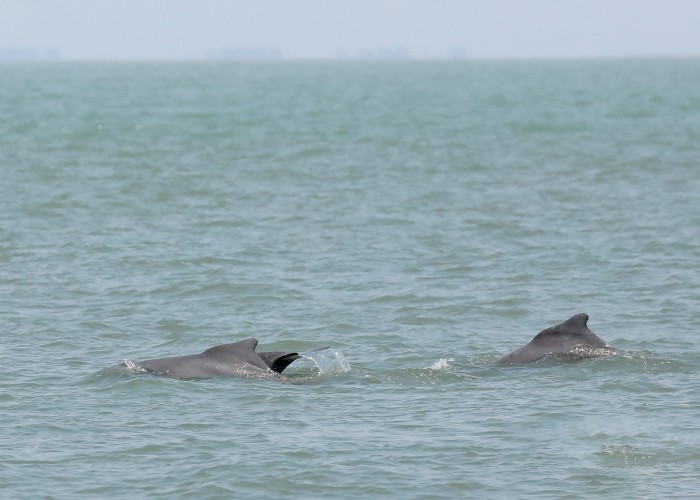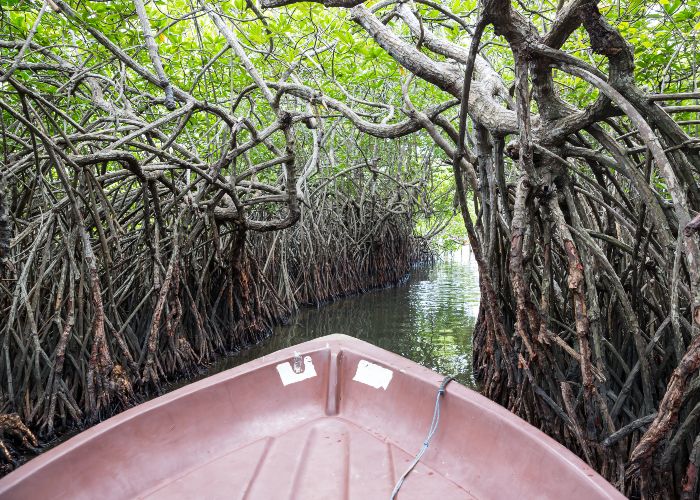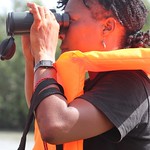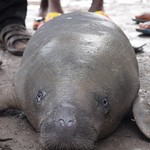Scroll Percentage: 0%
Large projects Guinea 2023
Protecting Our Waters: Safeguarding the African Manatee, Atlantic Humpback Dolphin, and Marine Turtles
Guinea conservation facts
Guinea, West Africa is considered one of the world's 25 biodiversity hotspots and is home to a wide array of species including 9000 species of plants, including 1800 endemics, 416 mammal, 917 bird, 107 reptile and 269 amphibian species. The status of biodiversity in the region is severely threatened. The exploitation of wildlife and birds greatly exceeds the rate of natural increase, leading to the disappearance of certain species. According to the IUCN Red list, Guinea is home to 346 threatened species.
Large projects in Guinea
The Mohamed bin Zayed Species Conservation Fund manage three conservation projects in Guinea, West Africa on behalf of Mubadala and its asset GAC (Guinea Alumina Corporation). In collaboration with the African Aquatic Conservation Fund, we are building local capacity while gathering baseline data to identify and mitigate threats to the African manatee. Our second project focuses on the Atlantic humpback dolphin, with partners CCAHD (Consortium for the Conservation of the Atlantic Humpback Dolphin) and Biotope conducting boat-based and interview surveys to document the species’ distribution, habitat preferences, and threats. In Guinea’s Tristao archipelago, our partner Chelonee is establish a field station for monitoring nesting sites, conducting field surveys, and performing genetic and habitat analysis of marine turtles.
African Aquatic Conservation Fund (AACF)
Guinea’s gentle giants: The African manatee (Trichechus senegalensis)
The AACF was created in 2014 by Dr. Lucy Keith Diagne and Tomas Diagne to address the severe declines in African manatee, cetacean, turtle and tortoise species that they were witnessing firsthand across the African continent.
CCAHD and Biotope
Quest for Humpback dolphin (Sousa teuszii) in Guinea
Biotope was born on 1993 with a fundamental mission: to assist any development project, from design to exploitation, applying consultation methods and resolving all regulatory obstacles related to environmental standards. Working with the CCAHD Foundation as an umbrella foundation to promote and support research and conservation actions throughout the species’ range and provide robust conservation advice on the Atlantic humpback dolphin.
Association Chelonee
Community conservation of marine turtles
Chelonee, established in 2016, is a scientific association studying and conserving sea turtles and their habitats in the French territories and Africa.
The African manatee project
Little is known about the African manatees in Guinea, which inhabit both the coastal regions and the interior waters of the Niger and Gambia rivers. This project marks the first dedicated research and conservation initiative focused on this species in Guinea. Through our partners, we train local researchers in manatee research and conservation techniques while conducting a comprehensive threat assessment of all manatee habitat areas throughout the country.
Additionally, we'll collect biological samples opportunistically to analyze and generate crucial insights into manatee population genetics, feeding ecology, and habitat usage in Guinea. The threat assessment findings will be shared with wildlife law enforcement agencies, with the aim to strengthen the enforcement of laws designed to protect this vulnerable species.
Progress in 2023 and next steps
This project focuses on conserving African manatees in Senegal and Guinea through on-the-ground studies to identify distinct populations, assess their numbers, mitigate threats, and understand their feeding ecology and habitat use.
This summer, AACF plans fieldwork at the Koulountou River in southern Senegal, where manatees were recently discovered on the Guinea side. AACF aims to determine the population using the Senegal and Niger Rivers and identify threats to increase protected areas.
AACF will continue to train African biologists and university students in manatee research and conservation techniques, providing hands-on experience in data collection, survey methods, and biological sampling.
AACF will share findings through social media, conferences, and scientific publications, fostering community engagement. Dr. Keith-Diagne will establish the African Manatee Alliance (AMA) to enhance collaboration among researchers, address key concerns, and support fundraising for conservation across the 21 countries where manatees are found.
"The funding for the African manatee project in Guinea has allowed us to train the largest group of African manatee researchers anywhere in Africa, and has made it possible for us, in just 3 short years, to learn more about the species and it's threats than almost anywhere else"
Lucy Keith-Diagne, Executive Director African Aquatic Conservation Fund
Humpback Dolphin project
Atlantic humpback dolphins are endemic to the (sub)tropical waters along the Atlantic coast of Africa. In many countries, their presence has primarily been recorded through opportunistic sightings, strandings, or bycatch reports, supplemented by a limited number of targeted field studies. To date, these efforts have confirmed the presence of Atlantic humpback dolphins in 14 range states, including Guinea.
This project aims to assess the distribution, habitat preferences, and abundance of Atlantic humpback dolphins in Guinea. By identifying key habitats and documenting the threats facing this species, we will collaborate with Guinean stakeholders to develop actionable recommendations to mitigate these risks and support dolphin conservation. As we gather more information about the status of dolphins in this region, we will engage local communities in long-term conservation initiatives to ensure their survival for future generations.

Progress in 2023 and next steps
To enhance our understanding of Humpback dolphin ecology, we continued regular expeditions in 2023, surveying and interviewing stakeholders such as port managers, fishmongers, conservationists, and local authorities.
The Biotope team has proposed an action plan for environmental education, which is currently being revised before submission to the CCAHD for validation. This plan includes tailored training and awareness-raising activities for diverse audiences.
Unfortunately, an oil depot blast in Conakry in December 2022 led to the postponement of planned fieldwork for AHD boat surveys in the Kamsar area, along with environmental education and capacity-building efforts for the CNSHB, now rescheduled for May 2024.
A significant aspect of our outreach focuses on engaging the community, particularly children. To connect with this audience, CCAHD is creating a children’s book commissioned from writer and illustrator Howard Gray, based on Ibrahima Sory Camara’s story. We anticipate publishing and releasing it in 2024.
Marine turtles project
Located 160 km from Conakry, the capital of Guinea, the Tristao archipelago is a vital marine protected area where endangered marine turtles coexist with local communities. At its heart lies Katrack Island, featuring a stunning 20 km sandy beach that serves as a nesting ground for Hawksbill, Green, and Olive Ridley turtles, making it a global hotspot for turtle conservation.
This project aims to collaborate with local communities to safeguard turtle nests, combat poaching, and mitigate habitat degradation. We will conduct DNA analysis to monitor the health of this endangered population and implement strategies to ensure their continued survival. Community engagement will extend to supporting a local school and dispensary, fostering a sense of ownership and stewardship among residents.
To guide this initiative, a doctoral student will investigate the effects of community-engaged conservation on nesting and foraging behaviors of marine turtles, ensuring that our efforts are both effective and sustainable.
Progress in 2023 and next steps
The primary focus has been the construction of a field research station in the Katfoura District. Chelonee has submitted the required construction documents to the Mining Society for approval, and we hope to commence construction after the rainy season.
Eco guards play a vital role in monitoring turtle nests and potential threats. We successfully recruited two additional eco guards from the Kapan community and will continue to track their progress.
The installation of new mesh enclosures at the research station has been very effective. In August, eco guards monitored 33 transplanted nests, all protected by wire cages from predators. Night patrols revealed a total of 4,020 eggs across these nests.
In June 2023, MBZF team members participated in an expedition to Loos Islands, aiming to install awareness panels on Soro and White Islands and to clear rubbish that washed up on the Island. However, bad weather limited their visit to Solo Island.
Community awareness remains a priority, and we conducted interviews with fishermen in areas where poaching was reported. Unfortunately, out of 50 fishermen surveyed, 32 admitted to catching young marine turtles. Ongoing awareness and education campaigns are essential.
Our main objective is to create a management plan that addresses both problem resolution and development opportunities.
"The turtle program is unique because its objective is to protect a species that faces several threats, and we involve local people in this protection effort. We began by assisting the local community before discussing conservation initiatives."
Hawa Kossinantao, General secretary, L'association Chélonée
Manatee workshop in Conakry
Five new rivers for manatees discovered
Good progress as Manatee fellows present results
MBZF team visits Conakry
Challenging Weather Conditions Impact June Survey Results
Katrcak Eco guards training
Chelonee and the “Sea Turtles Adventure” game
Giving the dispensary a much needed facelift
Leatherback turtle safely back home





















